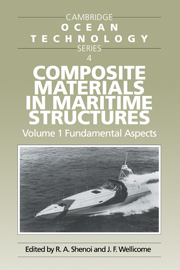Book contents
- Frontmatter
- Contents
- Preface
- List of Authors
- 1 A Strategic Overview
- 2 Background to Materials Science
- 3 Environmental Aspects
- 4 Production by Resin Transfer Moulding
- 5 An Engineering Approach to the Prediction of Elastic Properties of a Laminate
- 6 Mechanics of Orthotropic Laminae
- 7 Analysis of Laminated Composites
- 8 Theory of Sandwich Beams and Plates
- 9 Design of Anisotropic Panels
- 10 Finite Element Analysis of Composites
- 11 Theoretical Predictions of Failure Mechanisms and Strength
- 12 Considerations of Failure Theories in Design
- 13 The Procedures and Standards
- Appendix
- Index
3 - Environmental Aspects
Published online by Cambridge University Press: 04 August 2010
- Frontmatter
- Contents
- Preface
- List of Authors
- 1 A Strategic Overview
- 2 Background to Materials Science
- 3 Environmental Aspects
- 4 Production by Resin Transfer Moulding
- 5 An Engineering Approach to the Prediction of Elastic Properties of a Laminate
- 6 Mechanics of Orthotropic Laminae
- 7 Analysis of Laminated Composites
- 8 Theory of Sandwich Beams and Plates
- 9 Design of Anisotropic Panels
- 10 Finite Element Analysis of Composites
- 11 Theoretical Predictions of Failure Mechanisms and Strength
- 12 Considerations of Failure Theories in Design
- 13 The Procedures and Standards
- Appendix
- Index
Summary
INTRODUCTION
Composites offer high mechanical properties due to low density, a proven corrosion resistance, damage tolerance and fatigue resistance, leading to a long and relatively maintenance-free working life. This, combined with the flexibility of the manufacturing process, makes composites extremely suitable materials for use in a marine environment. The environmental stability and the maintenance of the initial performances are however dependent on correct material selection and good manufacturing practices. The marine application of composite materials has been characterised by several examples of failures and poor durability, such as osmosis, due to inadequate materials and working practices. The fire performance of composites is another topic which needs particular attention. It is well-known that composites offer the same if not a better level of protection to fire than traditional structural materials notwithstanding the fact that composite structures are often limited if not forbidden by current marine regulations for their combustibility and the consequent smoke emissions. Another important aspect is the safety and the health of people involved in boat and ship construction with these materials. In fact the chemical nature of these materials requires particular care both in the selection of materials and organisation of work. The scope of this Chapter is to give a review of the basic principles and the parameters which govern the behaviour of composite structures in a marine environment in order to provide the basic elements for a correct selection of materials, design and production techniques.
DURABILITY IN A MARINE ENVIRONMENT
The performances of composite structures under prolonged immersion and exposure to wind, rain and sun are generally good when compared with other usual construction materials.
- Type
- Chapter
- Information
- Composite Materials in Maritime Structures , pp. 44 - 85Publisher: Cambridge University PressPrint publication year: 1993
- 7
- Cited by

